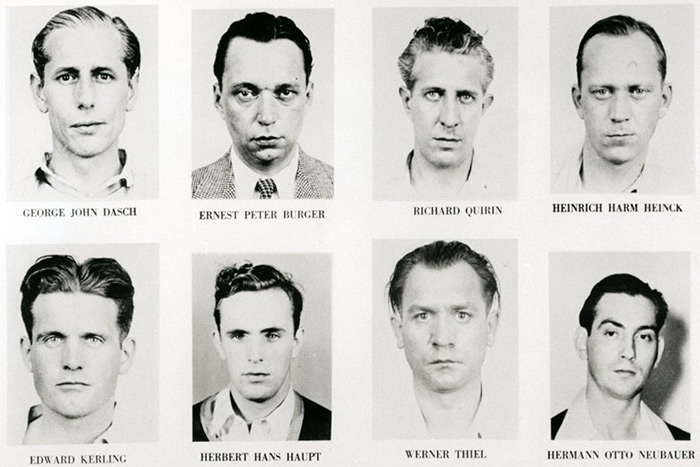The Night Nazis Landed in Amagansett

On a dark foggy night at 12:10 a.m. on June 13, 1942, a German submarine carrying four Nazi saboteurs surfaced 200 yards off the Atlantic Avenue beach in Amagansett and launched the men in a rubber boat toward shore. They intended to blow things up in America. Targets would be aluminum plants, aircraft factories, railroad junctions and department stores. They’d brought wooden boxes containing explosives, which they buried in the sand, and hoped to retrieve after blending in with our quiet community of fishermen and farmers. They planned to obtain a car, dig up this dangerous material and drive it into Manhattan to a hotel where they’d plan the assaults on their targets.
They succeeded that night in getting ashore. And they got away to New York City. But in the end, before they could do any damage, they were caught. Actually, the leader of the group, George Dasch, turned himself and all the others in. He survived to tell the tale. But the others were executed in electric chairs on Aug. 8.
Here in Amagansett, a re-enactment of the Nazi landing has been held on the beach every year. They do it on a weekend rather than on the exact date. And they do it around dusk rather than at midnight. Poetic license.

This year, though, rather than do a re-enactment, they held an indoor event about the landing at the Amagansett Coast Guard Station, less than a hundred yards from the actual landing spot. Officials here had come into possession of FBI documents, thousands of them, that had been held for 30 years, so as not to be available to tell the true story. J. Edgar Hoover, the head of the FBI, had bungled the job of catching the saboteurs. For a considerable time, they believed the turncoat saboteur was a fake. Then they hid that he’d turned the others in. They wanted the public to think that the FBI agents were the heroes.
Genie Henderson, a local author, wrote a script using Movietone News film footage and readings of the documents, which was performed recently in the station boathouse. She was assisted by Hugh King, Isabel Carmichael, David Cataletto, Ted Hults and others.
Of special interest was why the landing took place at Amagansett. The reason was that Dasch, the leader, had spent several summers on the East End years earlier, and so when asked by Germany’s dictator Adolf Hitler for a plan to put this operation into effect, chose Amagansett — actually Southampton — but in the fog they’d been thrown off course.
Dasch grew up on a farm in Germany then emigrated to the United States in 1923 because times in Germany were hard. He rented an apartment in Manhattan, wooed and married an immigrant named Rose Marie Guille in 1930, and took up a career as a waiter in the city. He came out to the Hamptons and worked waiting tables at the Irving Hotel in Southampton, the Sea Spray Inn, (since burned down), adjacent to the Main Beach Pavilion in East Hampton, and at an East Hampton restaurant called the Oaks Inn, (now a landscaping office near the Red Horse Market). George got around by bicycle. His wife took in laundry.
What a lovely, quiet spot the Hamptons was then. And also, there was the railroad. They could swiftly get to Manhattan.
In 1936, Hitler, secretly building an army and navy and threatening neighboring European countries, called out to all young German men living abroad to come home. Dasch, in Manhattan, decided to answer the call. His wife said she should go too, but he said he would send for her when he got settled.
He never did get settled. As he told Hoover when he was turning the others in, when he saw how brutal Hitler was, he wanted only to get back to Manhattan. Leading the sabotage operation would be his ticket back. He’d planned it from the get-go.
Also, things did not go smoothly in Amagansett. World War II had begun only six months before. President Franklin Roosevelt saw that German submarines were masters of the Atlantic. Earlier, one surfaced just off Atlantic City and sank an American freighter right in front of the boardwalk there. As a result, Roosevelt ordered three Naval radio stations to be built along the Atlantic Coast to monitor the subs. They’d listen in on radio instructions, then determine exact locations by triangulation. Thus radio stations were built on the beach in Maine, Florida and Amagansett. Unfortunately, the triangulation never revealed the location of sub U-202 bringing the saboteurs to right in front of the Amagansett station. Also, the sub landed just in front of the next-door Amagansett Coast Guard Station, where Naval officers, looking for Germans, had guns.
Interestingly, at the insistence of Hitler, Dasch and the others waded ashore wearing German military uniforms. If caught on the beach they could be treated as officers. As no one saw them when they waded ashore, the men quickly changed into American fishermen’s clothes, burying the uniforms with the explosives.
In short order, however, Dasch did encounter a Coast Guardsman with a flashlight walking the beach at that hour — the beach was off limits to the public at night. Dasch tried to bribe the Coast Guardsman with $300 to forget what he saw and the Coastguardsman took the cash and ran off into the fog to sound the alarm with his superiors at the nearby Coast Guard Station. But by that time, the saboteurs were away into the woods and off to the railroad station at Amagansett. There, dressed as fishermen, they boarded the 6:59 a.m. train to Manhattan and safety. Gone.
The next day, locals heard about all this secret military activity with Navy, Coast Guard and even an Army unit bivouacked who’d come onto the scene, but nobody would say what it was about.
Three weeks later, Hoover gave a nationwide speech over the radio about how FBI vigilance caught the saboteurs. Such a lie. Newspapers nationwide ran the story on the front page but people wondered if a local in Amagansett had worked with the saboteurs. Were there more still in the community? There had to be more.
It was an interesting evening with Henderson and her crew performing. Wonder what they will come up with next year.









